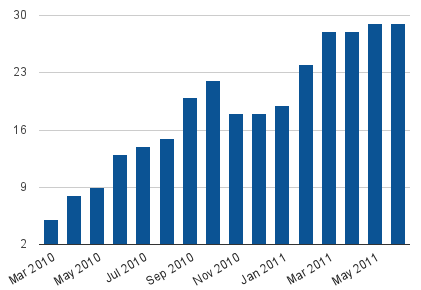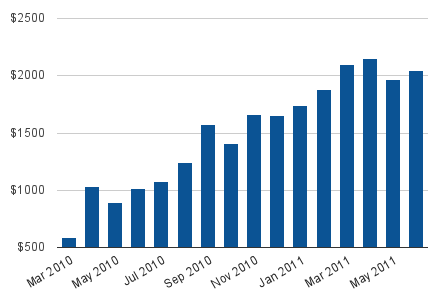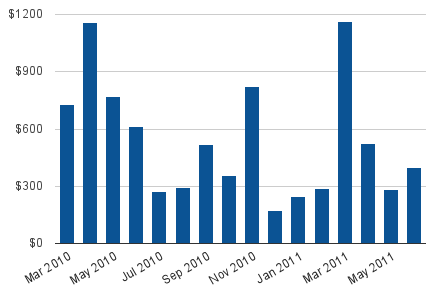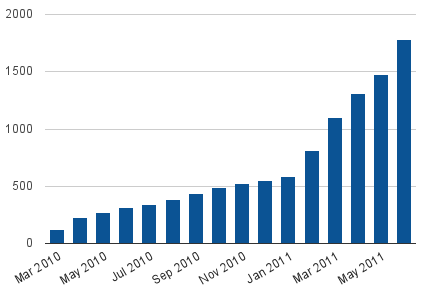The number of OpenSim grids accepting the multi-grid, hypergrid-enabled Open Metaverse Currency (OMC) has continued to grow in the first half of this year, now at an all-time high of 29 grids. Meanwhile, the number of registered users has tripled since the start of the year. In addition, the total amount of OMC in circulation has been generally increasing since it was launched last spring.
However, the value of transactions each month has varied considerably during this time, possibly due to the number of changes in the hypergrid protocol, which made it difficult to travel between grids. In addition, OMC shoppers would be worried about not being able to bring purchases back to their home grids — while OMC merchants worry about the possibility that their goods could leave their home grids and be illegally distributed elsewhere.
The OMC is fully convertible, and can be bought and sold for US dollars, British pounds, Euros, and Swiss francs, and can also be traded for Second Life ‘s Linden dollars. The OMC has an exchange rate of around 270 OMC to US $1.
OMC is backed by Austian virtual currency exchange Virwox, which publishes real-time statistics about the OMC. Virwox is better known as one of the leading exchanges for Linden dollars in Europe. As of May, more than 30,000 users have traded over US$30 million worth of Linden dollars on the exchange.
Grid Growth
Despite the drop in grid numbers at the end of 2010, the currency has not only risen to where it used to be, but exceeded it to reach a new record high. In the first half of the year, the number of grids that OMC is accepted on grew from 18 in January to 29 at the end of June — 28 OpenSim grids, plus Second Life.
As the number of grids the currency is available on continues to rise, the currency becomes more and more useful. With more grids accepting OMC, this means more opportunity for virtual shopping destinations in OpenSim — as well as a larger resident base from which to draw registered OMC users.

User and Transaction Growth
The total amount of OMC in circulation has been higher in the first half of this year than ever before. Despite some setbacks over the past two months, the total amount of the currency in circulation rose to over US$2,000 — which is still a relative drop in the bucked compared to the amount of money circulating in private currencies on the Avination and InWorldz commercial grids.

The value of monthly transactions, which jumped sharply in March of this year, has fallen again from almost $1,200 in March to less than $300 in May. Transactions recovered slightly in June, reaching around $400, but are still much lower than at the end of the first quarter.

Although the total value of transactions has dropped, the number of users has increased significantly from 1,100 in March to 1,800 at the end of June. This increase in users means that there are more prospective buyers for merchants that accept OMC payments.

The OMC currency doesn’t belong to any one grid. Rather, it is stored on the Virwox site, in the user’s account, the same way that PayPal stores money for its users. Deposits or withdrawals can made from the account at any times.
Similar to PayPal payments in OpenSim, each transaction must be authorized on the Virwox website itself, for maximum security. Each grid that enables OMC also has to be approved by Virwox, in order to ensure the safety of its users.
OMC works with all of the existing Linden shopping scripts, so merchandise cam be delivered in-world at the time of purchase. Merchants can scam the system — as they can in Second Life — by promising one product and delivering something else. However, a grid that doesn’t police its merchants and receives  too many complaints from shoppers stands to lose its OMC connectivity.
Because the OMC works across hypergrid teleports, a shopper can travel to other grids to buy merchandise and bring the merchandise with them back to their own grid. However, due to new improvements in hypergrid security, not all items can be transported to other grids. Shoppers are encouraged to buy from merchants they know, or to experiment with smaller items or freebies, to ensure that they can successfully transport goods back to their own grid.
Beyond OMC
Since support for the Avination grid’s virtual currency rolled out in February, Virwox has also traded more than 20 million of Avination’s C$, approximately US$74,000. U.K.-based Avination is the third largest public OpenSim grid by land area as of mid-June.
The OMC exchange volume on Virwox, however, is just 12 million OMC, or about US$44,000.
One reason for the difference in volume is that Avination is a closed, commercial grid. Content cannot be taken off the grid via hypergrid teleports or region OAR file backups or inventory IAR backups. Because of this, merchants are more comfortable selling their virtual goods in that environment.
Most of the large OMC-enabled grids, however, are hypergrid-enabled, which allows goods to be taken to other grids where they could be exported and possibly distributed illegally. As a result, many merchants are hesitant about selling their gods there. In addition, given the hypergrid compatibility issues as a result of OpenSim upgrades, shoppers may be wary of spending money on other grids in there’s a possibility that they wont be able to bring the merchandise back with them to their own grid.
Recently, closed commercial grids have begun adopting the OMC as well, in order to avoid the problems associated with managing their own virtual currencies. These grids haven’t yet grown to the point where they constitute a sizeable retail market but may do so in the future.
- Firestorm opens office in OSGrid - October 17, 2012
- 5 ways to use achievements for viral marketing - September 12, 2012
- Cloud Party is a social platform, not a business venue - June 21, 2012
